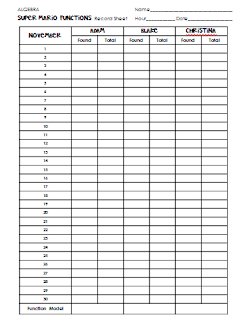The Tongue Twister Lab Activity prompts students to gather data, analyze visually, and use an informal model to make a prediction. (CCSS 8.SP.A.2) This activity not only gives students a context as a foundation, but it also compartmentalizes the process used with regression via technology. Each student is provided a list of Halloween tongue twisters to review, select, and present to his team. Then the team selects one twister to use for data collection. This activity is intended to be completed manually...think large graph paper, meter sticks, etc.
 |
| Tongue Twister Lab Activity |
Teachers can integrate a class discussion to review proportional vs. non-proportional relationships, linear vs. nonlinear, comparing rate of change between trend lines from different teams, etc. And then it's time to formally fit a function to the data with the use of technology. The duration of this lesson generally spans two 80-minute periods.
It may be helpful to provide students with a Regression Guide to follow when completing the steps in a graphing calculator. Don't be discouraged if it takes several attempts for students to become fluent with the graphing calculator. Additional problems can provide formative assessment on their progress with technology and an opportunity to interpret the rate of change and initial value within new contexts of data.
 |
| Cell Phone Problem |
And this Election Day problem is time-sensitive; however, the idea can be adjusted to any election being conducted in your area.
The following activity is most conducive to cooperative learning teams. Students are provided details about three players gathering gold coins in a marathon month of the Super Mario game. The scenarios yield linear, exponential, and quadratic function models. Not only does this activity prompt students to investigate patterns and utilize regression via technology, but it also overviews the three major functions included in Algebra 1.
 |
| Team Problem |
 |
| Super Mario Functions Record Sheet |
This activity set highlights Common Core State Standards 8.SP.A.2, HSS-ID.B.6a, HSS-ID.B.6c, and HSS-ID.C.7 included in 7th and 8th Accelerated Algebra 1.



+Title+Pic.png)